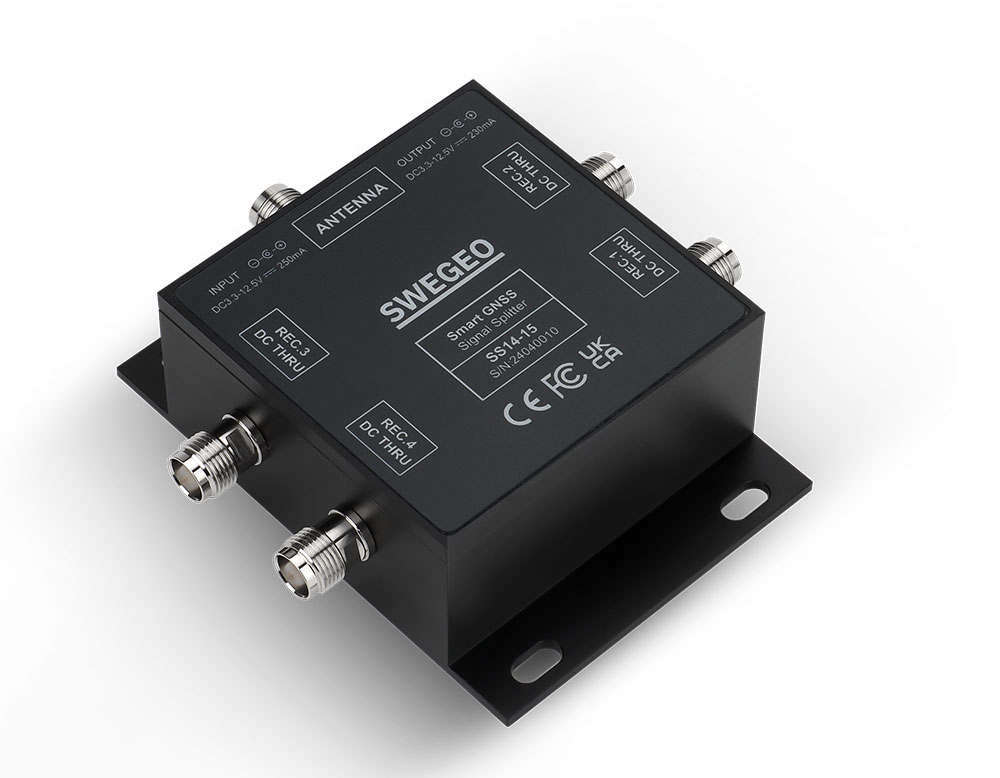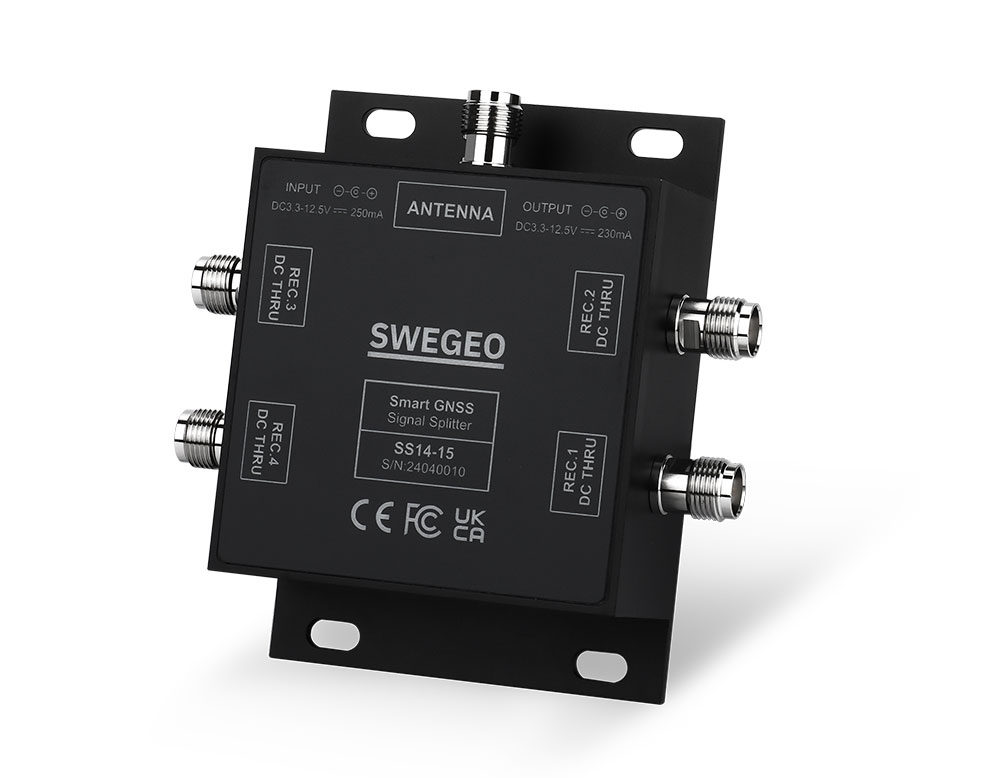

Swegeo SS14-15
Active GNSS Splitter with 4 Ports and 15 dB Gain
Key Feature
- The Swegeo SS14-15 is an active GNSS signal splitter with a built-in amplifier that delivers 15 dB of gain for strong and clear signal reception.
- It allows one antenna to connect to up to four receivers, supporting full GNSS band signals.
- The splitter’s symmetrical design ensures delay consistency across all output channels.
- Its robust and durable construction makes it ideal for high-precision GNSS applications in challenging environments.
Amplification to Compensate for Signal-Splitting Loss
Provides amplification to ensure strong and clear signals reach each receiver despite signal splitting.
Accepts Power from All Attached Receivers
Can be powered by any of the connected GNSS receivers, offering flexible power options.
Allows Up to Four GNSS Receivers to Share a Single Antenna
Enables multiple GNSS receivers to efficiently share one antenna, reducing hardware requirements and costs
Robust Package
Designed with a durable and reliable build to withstand harsh environmental conditions and ensure long-lasting performance.
Long Cable Runs & Distributed GNSS Systems:
The SS14-15 active splitter is used in scenarios where the GNSS antenna’s signal needs to be shared and cable lengths or splitting losses are a concern. For example, in an airport or seaport control center, a single antenna on the roof might feed multiple timing and navigation systems deep inside a building via long coax runs. The built-in 15 dB gain of the SS14-15 compensates for cable loss, ensuring each of the four output receivers still gets a strong, clear signal. Air traffic control systems, ground vehicle tracking, and facility time servers can all share one antenna without degradation, which simplifies installation and maintenance (only one antenna to keep clear of obstructions or to calibrate).
GNSS Signal Distribution in Buildings:
Many indoor facilities such as testing laboratories, airplane hangars, or large factories bring GNSS signals inside to keep systems online or allow testing of equipment under roof. The SS14-15 can be part of a distribution network: one exterior antenna’s feed is amplified and split to multiple indoor re-radiating antennas or directly into simulators/receivers at different lab stations. For instance, an aerospace manufacturer could use SS14-15 to feed live sky signals to test benches spread across a hangar so that GPS receivers in new aircraft can be initialized and tested indoors. The amplified splitter guarantees that even the farthest test bench receives adequate signal strength. Additionally, like the passive model, it’s powered by any connected receiver, offering flexibility in how the system is powered (one dedicated power injector or simply by one of the plugged-in devices).
Mobile Command Centers:
Emergency mobile command vehicles or broadcast media trucks often have multiple GNSS applications on board (navigation, geo-tagging, communication sync). By installing the SS14-15, these vehicles can use one high-quality antenna and split its feed to all onboard systems. The advantage of the active splitter here is that it maintains strong signal levels despite splitting – important when vehicles might use longer cables routed through masts or quick-disconnect panels. So, whether it’s a disaster response trailer that needs GPS for navigation and also to timestamp each piece of outgoing radio communication, or a TV broadcast truck using GPS for both vehicle tracking and synchronizing video streams, the SS14-15 ensures every system gets a robust signal and quick satellite lock, improving the readiness and reliability of the mobile unit.
| Feature | Specification | Feature | Specification |
|---|---|---|---|
| Nominal Impedance | 50 ohm | Gain | 15 ±1.0 dB (Typ. @25°C) |
| Phase Balance | 2.0° Typ., 5.0° Max | Amplitude Balance | ±0.5 dB |
| Maximum RF Input (Antenna) | 10 dBm | Dimensions | 105 × 75 × 37 mm |
| Connector | 5 × TNC (Female) | Weight | 250 g |
| Body Material | Aluminum Alloy 6061-T6 | Mounting | Four screw holes |
| Frequency Range | 1154 ~ 1621 MHz | DC Input | 3.3 ~ 12.5 V DC (from any port) |
| Noise Figure | ≤2.0 dB @25°C | Antenna Current | ≤250 mA |
| VSWR | ≤1.5:1 typ. / 1.8:1 max | Splitter Current | ≤45 mA |
| Input 1 dB Gain Compression Point | ≥ -10 dBm | Operating Temperature | -40°C ~ +85°C |
| Storage Temperature | -45°C ~ +85°C | Humidity | 95% Non-condensing |
| Ingress Protection | IP67 |


Swegeo SS14-15
Active GNSS Splitter with 4 Ports and 15 dB Gain
Key Feature
The Swegeo SS14-15 is an active GNSS signal splitter with a built-in amplifier that delivers 15 dB of gain for strong and clear signal reception.
It allows one antenna to connect to up to four receivers, supporting full GNSS band signals.
The splitter’s symmetrical design ensures delay consistency across all output channels.
Supported signals include:
GPS/QZSS: L1, L2, L5
QZSS: L6
GLONASS: G1, G2, G3
BeiDou: B1, B2, B2a, B3
Galileo: E1, E5a, E5b, E6
L-band correction servicesIts robust and durable construction makes it ideal for high-precision GNSS applications in challenging environments.
OVERVIEW
Multi-Constellation GNSS Support
Provides reliable and robust signal reception from GPS, GLONASS, Galileo, and
BeiDou systems, ensuring comprehensive coverage and improved accuracy.
Dual Antenna Configuration
Enhances positioning accuracy and performance, particularly in challenging
environments, by using two antennas to better mitigate signal obstructions and
multipath effects.
USE CASES
Long Cable Runs & Distributed GNSS Systems:
The SS14-15 active splitter is used in scenarios where the GNSS antenna’s signal needs to be shared and cable lengths or splitting losses are a concern. For example, in an airport or seaport control center, a single antenna on the roof might feed multiple timing and navigation systems deep inside a building via long coax runs. The built-in 15 dB gain of the SS14-15 compensates for cable loss, ensuring each of the four output receivers still gets a strong, clear signal. Air traffic control systems, ground vehicle tracking, and facility time servers can all share one antenna without degradation, which simplifies installation and maintenance (only one antenna to keep clear of obstructions or to calibrate).
GNSS Signal Distribution in Buildings:
Many indoor facilities such as testing laboratories, airplane hangars, or large factories bring GNSS signals inside to keep systems online or allow testing of equipment under roof. The SS14-15 can be part of a distribution network: one exterior antenna’s feed is amplified and split to multiple indoor re-radiating antennas or directly into simulators/receivers at different lab stations. For instance, an aerospace manufacturer could use SS14-15 to feed live sky signals to test benches spread across a hangar so that GPS receivers in new aircraft can be initialized and tested indoors. The amplified splitter guarantees that even the farthest test bench receives adequate signal strength. Additionally, like the passive model, it’s powered by any connected receiver, offering flexibility in how the system is powered (one dedicated power injector or simply by one of the plugged-in devices).
Mobile Command Centers:
Emergency mobile command vehicles or broadcast media trucks often have multiple GNSS applications on board (navigation, geo-tagging, communication sync). By installing the SS14-15, these vehicles can use one high-quality antenna and split its feed to all onboard systems. The advantage of the active splitter here is that it maintains strong signal levels despite splitting – important when vehicles might use longer cables routed through masts or quick-disconnect panels. So, whether it’s a disaster response trailer that needs GPS for navigation and also to timestamp each piece of outgoing radio communication, or a TV broadcast truck using GPS for both vehicle tracking and synchronizing video streams, the SS14-15 ensures every system gets a robust signal and quick satellite lock, improving the readiness and reliability of the mobile unit.
APPLICATIONS


TECHNICAL SPECIFICATIONS
| Feature | Specification | Feature | Specification |
|---|---|---|---|
| Nominal Impedance | 50 ohm | Gain | 15 ±1.0 dB (Typ. @25°C) |
| Phase Balance | 2.0° Typ., 5.0° Max | Amplitude Balance | ±0.5 dB |
| Maximum RF Input (Antenna) | 10 dBm | Dimensions | 105 × 75 × 37 mm |
| Connector | 5 × TNC (Female) | Weight | 250 g |
| Body Material | Aluminum Alloy 6061-T6 | Mounting | Four screw holes |
| Frequency Range | 1154 ~ 1621 MHz | DC Input | 3.3 ~ 12.5 V DC (from any port) |
| Noise Figure | ≤2.0 dB @25°C | Antenna Current | ≤250 mA |
| VSWR | ≤1.5:1 typ. / 1.8:1 max | Splitter Current | ≤45 mA |
| Input 1 dB Gain Compression Point | ≥ -10 dBm | Operating Temperature | -40°C ~ +85°C |
| Storage Temperature | -45°C ~ +85°C | Humidity | 95% Non-condensing |
| Ingress Protection | IP67 |


